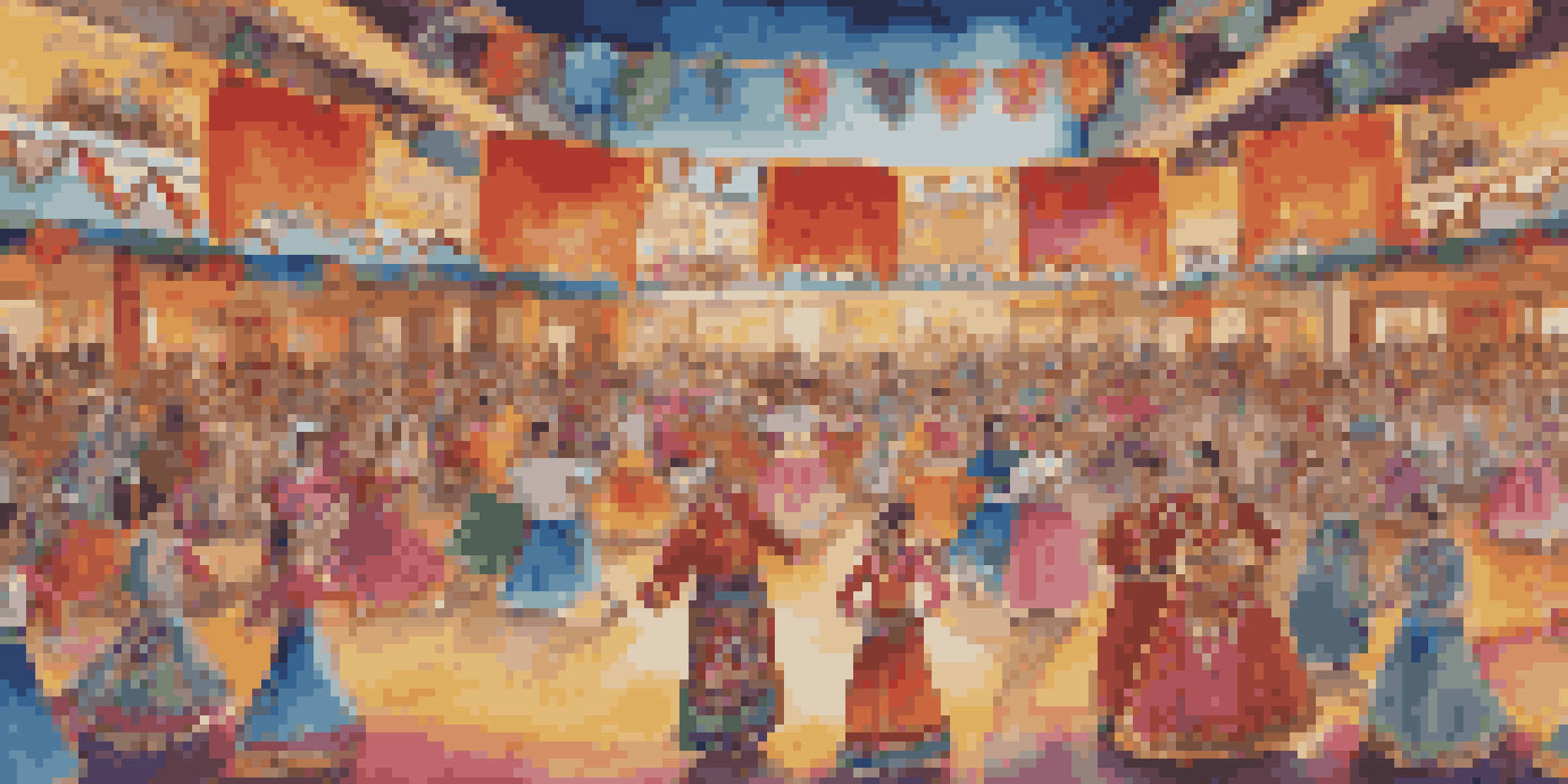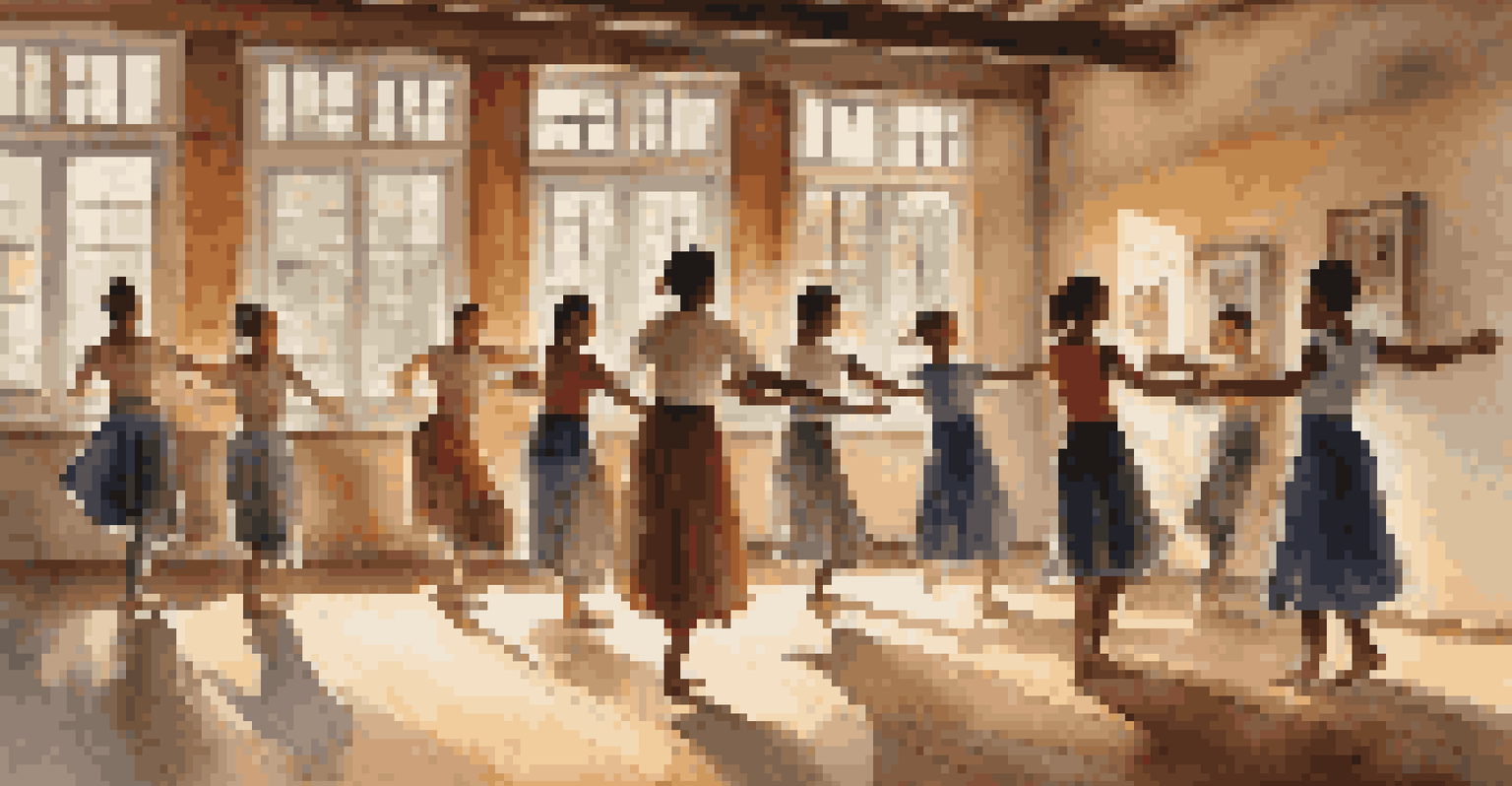The Impact of Globalization on Folk Dance Traditions

Understanding Folk Dance Traditions in a Global Context
Folk dance traditions are rich expressions of culture, often passed down through generations. They embody the stories, values, and identities of communities around the world. However, as borders blur and cultures intermingle, it's crucial to understand how these traditions are affected by globalization.
Dance is the hidden language of the soul.
Globalization refers to the increasing interconnectedness of cultures, economies, and societies worldwide, often driven by technology and trade. This phenomenon can introduce new elements into folk dances, sometimes enriching them but other times leading to a dilution of original practices. The challenge lies in balancing tradition with the influences of a globalized world.
To illustrate, consider how traditional Irish dance has gained immense popularity through shows like 'Riverdance.' While this exposure has brought Irish dance to a broader audience, it also raises questions about authenticity and the preservation of its roots. This duality is a common thread across various folk dance traditions worldwide.
The Positive Effects of Globalization on Folk Dance
One significant positive impact of globalization on folk dance is the opportunity for cultural exchange. Dancers and choreographers can now collaborate across continents, blending styles and techniques that might have otherwise remained isolated. This fusion can lead to innovative performances that celebrate diversity while keeping traditional elements alive.

Additionally, globalization allows for greater exposure and appreciation of folk dances. Festivals and cultural events now showcase a variety of dance forms, promoting understanding and respect for different heritages. For instance, events like the World Folk Dance Festival attract participants from around the globe, fostering connections and shared experiences among dancers.
Globalization Enriches Folk Dance
Cultural exchange through globalization allows for innovative blends of folk dance styles, fostering diversity while preserving traditional elements.
Moreover, the digital age has enabled folk dance enthusiasts to share their performances online, reaching audiences far beyond their local communities. Social media platforms serve as virtual stages, where traditional dances can be experienced by anyone, anywhere, encouraging a renewed interest in preserving these cultural practices.
Challenges Faced by Folk Dance Traditions Due to Globalization
Despite the benefits, globalization also poses challenges for folk dance traditions. One major concern is the commodification of culture, where dances are reduced to mere entertainment for profit, often stripping away their cultural significance. This can lead to a superficial understanding of the traditions, undermining their historical context.
Culture is the widening of the mind and of the spirit.
Furthermore, as global trends dominate, local styles may struggle to compete for attention. For example, a traditional dance might become overshadowed by more commercially viable performances, risking its survival. This is particularly evident in regions where modern dance forms are rapidly gaining popularity, potentially sidelining indigenous practices.
Lastly, the loss of language and context can occur when folk dances are presented without their cultural narratives. Dancers may perform movements without understanding their meanings or the stories they convey. This disconnect can erode the rich tapestry of traditions that folk dances represent, leading to a homogenized version of cultural expression.
Preserving Authenticity Amidst Global Influences
As the landscape of folk dance evolves, preserving authenticity becomes a vital concern. Communities must find ways to honor their traditions while adapting to new influences. This balance can be achieved through education and community engagement, ensuring that younger generations understand and value their cultural heritage.
Workshops, classes, and local performances can serve as platforms for teaching traditional dances, allowing them to thrive alongside contemporary forms. By involving community members in the learning process, folk dances can maintain their significance and continue to evolve organically. This approach fosters a sense of ownership and pride in cultural practices.
Challenges of Cultural Commodification
Globalization can lead to the commodification of folk dances, risking their cultural significance and overshadowing local traditions.
Moreover, documentation plays a key role in preserving authenticity. Recording performances, collecting oral histories, and archiving dance styles can help safeguard these traditions for future generations. This combined effort of education and documentation can create a vibrant space where folk dance traditions flourish in a globalized world.
Case Studies: Globalization and Specific Folk Dance Forms
Examining specific folk dance forms can provide deeper insights into the effects of globalization. For instance, the tango, originally a dance of the working-class neighborhoods in Buenos Aires, has transformed into a global phenomenon. While this recognition has brought economic benefits, it also raises questions about the preservation of its cultural roots.
Similarly, the hip-hop culture, which has its origins in marginalized communities, has experienced a similar journey. It began as a form of expression but has now become a mainstream global movement. This evolution highlights how folk dances can adapt and thrive, but also how their original essence can be altered in the process.
These case studies demonstrate that while globalization can enhance visibility and opportunities for folk dances, it also necessitates ongoing discussions about authenticity, ownership, and representation. Communities must navigate these complexities to ensure their stories and identities remain at the forefront of their dance traditions.
The Role of Technology in Shaping Folk Dance Traditions
In today's world, technology plays a pivotal role in shaping folk dance traditions. From online tutorials to social media platforms, dancers can easily access and share techniques from various cultures. This accessibility can enrich folk dance practices, allowing for a broader understanding of different styles and movements.
However, the reliance on technology also poses challenges. As online content proliferates, distinguishing authentic sources from those that may misrepresent traditional dances becomes crucial. Dancers and enthusiasts must remain discerning consumers of digital content to ensure they are honoring the true essence of their cultural practices.
Preserving Authenticity is Vital
Communities must prioritize education and documentation to maintain the authenticity of folk dance traditions amidst global influences.
Ultimately, technology can serve as a bridge between tradition and modernity. By harnessing its power thoughtfully, communities can promote their folk dance traditions while adapting to the ever-changing landscape of the global cultural scene. This harmonious relationship between technology and tradition can lead to a vibrant future for folk dances.
Looking Ahead: The Future of Folk Dance Traditions
As we gaze into the future, the fate of folk dance traditions amid globalization is still being written. It's essential for communities to remain proactive in preserving their cultural practices while also embracing the influences that come with globalization. This dual approach can lead to a dynamic evolution of folk dance that honors the past while looking forward.
Education will be a cornerstone of this future. By instilling a sense of pride and knowledge about their cultural heritage, younger generations can carry the torch of tradition into a globalized world. Encouraging participation in local dance groups and cultural events can foster a sense of belonging and identity.

Ultimately, the future of folk dance traditions will depend on the collective efforts of communities, educators, and dancers. By navigating the complexities of globalization with intention and respect, we can ensure that these vibrant cultural expressions continue to thrive for generations to come.